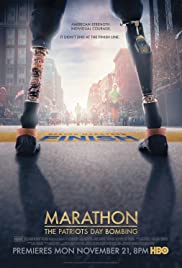
MARATHON: THE PATRIOTS DAY BOMBING
US, 2016, 108 minutes, Colour.
Directed by Ricki Stern, Annie Sundberg.
This documentary for American television goes back to the Boston Marathon on, 2013, the crowds of spectators, the fine day, the many running, the two explosions which killed four people and injured hundreds of others. The film incorporates a great deal of actual footage, of Boston that day, of the crowds gathering, of the race itself, of the explosions, close-ups of the injuries and the on the ground treatment, examination of footage to highlight the presence of the bombers… This is all skilfully put together.
While this is a film about inhumanity, the story of the bombers, well explored and dramatised, is not at the centre. This is a film about humanity, a focus on three families of survivors – staying with them over a period of several years, especially for their medical care and rehabilitation as well as the spirit of survival and possibilities of hope.
As regards the bombers, the narrative about them is inserted into the broader narrative of the survivors. There is the quick identification of the bombers, explanation of their presence in the United States, the family’s origins in Dagestan, the dysfunctional family, the sports activities of the two men, the older brother and his educating his younger brother, yet the independence of the younger brother. Background is filled in of the pursuit, the death of the older brother, the younger one hiding on the boat, his being arrested, the background of the building of the bombs, the ideology, she Hardy mentality, imprisonment, the court case and the death sentence.
However, as has been said, the focus is on the better aspects of human nature. The three key families are introduced at the beginning of the film, where the audience may or may not know about the ordeals and the lives of the survivors. The focus of the film is certainly on two brothers who were injured, then on a family with the mother and daughter injured, and then an engaged couple.
Most of those who are seen in close-up, with the background of their family members, lost one limb, some of them losing two legs.
The film shows a great deal of the hospital treatment, the surgery, close-ups of the injuries, the prospects – and the support of the family.
A great deal of attention is given to prosthetics, the developments and possibilities of artificial limbs, the attention needed to enable those with the limbs to attach them, to make them flexible, to be able to use them, to walk, even to run. The engaged couple were also taken in, not the usual entry, to the water Reed centre for disabled veterans. The couple welcomed, participated in the activities, made friends with many of the veterans, the other man, Patrick Downes, eventually able to go into a marathon for the disabled, his girlfriend watching him from her wheelchair. She is particularly strong because she lost both legs. And this is true, of the story of a mother and daughter, especially where the mother, Celeste Corcoran, lost both legs and participated in a strong recovery.
The film serves as a record of the tragedy itself, of the resilience of human nature, and a close-up of medical care, surgery and rehabilitation.
The year after this film was screened, David Gordon Green directed Stronger, based on a memoir by another victim, Jeff Bauman. Later, Mark Wahlberg starred in a recreation of the events and the pursuit of the bombers, Patriots Day.